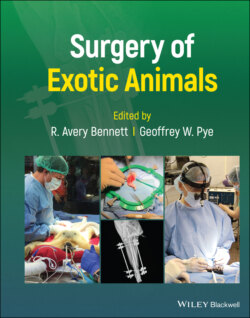Читать книгу Surgery of Exotic Animals - Группа авторов - Страница 25
Instrumentation and Equipment Hemostatic Aids
ОглавлениеThe average cotton‐tipped applicator (CTA) holds approximately 0.1 ml of blood when completely soaked and a 4 × 4 gauze sponge holds 10 ± 2 ml (Hughes et al. 2007). The total blood volume of small mammals is 57 ml/kg of body weight (Jenkins 2000; Bennett 2009). If a patient loses 10–15% of total blood volume (approximately 1% of body weight), it is generally considered safe. Most mammals experience hypovolemic shock and release large amounts of catecholamines with loss of 15–20% of the total blood volume. Loss of 20–30% of the total blood volume can have life‐threatening consequences (Jenkins 2000; Bennett 2009). As an example, if a 50 g mouse loses more than five CTAs full of blood, it is equivalent to more than 20% of the blood volume (Harkness 1993). Table 1.1 shows approximately 20% of the blood volume of common rodent pets.
Magnification is an aid for hemostasis (see Chapter 3). What would seem a small amount of blood to the naked eye observer appears to be major blood loss when magnified drawing the surgeon's attention to the hemorrhage and the need to arrest it. Additionally, small vessels can be identified and controlled more easily when working under magnification.
Hemostatic clips are available in various sizes including microclips. These are very useful for controlling hemorrhage in small patients, where it is difficult to accurately place a ligature. Additionally, they can be applied in deep, hard‐to‐reach locations. With some types of hemostatic clips, both straight and right‐angled appliers are also available (Figure 1.3). This applier makes it easier to get under a hemostat to apply a clip to a severed vessel.
Table 1.1 Loss of approximately 20% of total blood volume results in cardiovascular compromise with potentially life‐threatening consequences.
Source: Harkness (1993), Jenkins (2000), Harkness et al. (2010).
| Species | 20% of blood volume (ml) |
|---|---|
| Gerbil | 1.2 |
| Hamster | 1.4 |
| Rat | 4.0 |
| Guinea pig | 4.5 |
Twenty percent of the approximate blood volume of rodents.
Sterile CTAs are useful for atraumatic tissue dissection and manipulation. They can be used to apply pressure to damaged vessels allowing a clot to form. Use moistened CTAs when using them for tissue manipulation and dissection and dry ones to absorb fluids.
Absorbable gelatin sponge is made from treated purified gelatin solution. It is capable of absorbing many times its weight in blood and also provides a scaffolding for clot formation. It is completely absorbed in 4–6 weeks. Surgicel (Ethicon, Inc., Sommerville, NJ) is oxidized regenerated cellulose resembling cloth. It is a hemostatic aid that adheres nicely to moist tissues, but is not capable of absorbing much fluid and does not adhere well to dry tissue. Gelatin sponges are thick and absorb more fluid than oxidized regenerated cellulose but are prone to becoming dislodged from the tissue.
Topical thrombin is commercially available and when applied uses the patient's fibrinogen to form a fibrin clot. It is most useful for oozing and minor bleeding from capillaries and venules where standard surgical techniques are ineffective at halting the hemorrhage. It can be applied directly to the source of hemorrhage or can be applied onto gelatin sponge that is then placed over the site of hemorrhage. A hemostatic “taco” can be made of gelatin sponge wrapped in oxidized regenerated cellulose and soaked in topical thrombin and is very effective for controlling hemorrhage (Figure 1.4).
